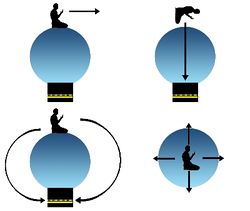Salah
Salāh or salāt (صلاة) is one of the Five Pillars of Islam. It is the practice of formal prayer in Islam, and is compulsory (fard) for all Muslims. It is a ritual prayer, having prescribed conditions, procedures, and times. The prescribed time periods (waqt) for daily prayers are as follows:

Top-right: People who are located on the opposite 'side' of the earth would have to pray vertically down towards the center of the earth, and would also blaspheme against Allah, because they defecate toward the direction of the Ka'aba when they answer the call of nature.
Bottom-left: If we use the traditional Muslim method of determining qiblah (i.e. a great circle) this would still be blasphemous because you would be simultaneously praying with your face and backside aimed towards the Ka'aba.
Bottom-right: There is one point on the opposite 'side' of the earth where any direction for all 360 degrees would be facing 'towards' Mecca and consequently, there would be no one direction that would be the correct one.
- Salat Al Fajr – Dawn to sunrise.
- Salat Al Zuhr – After true noon until Asr.
- Salat Al Asr - Afternoon.
- Salat Al Maghrib – After sunset until dusk.
- Salat Al Isha'a – Dusk until dawn.
According to the Qur'an[1] Muslims must pray towards the Ka'aba (qiblah being the direction that one has to face in order to do this). This is only possible on a flat earth model.
Due to the sphericity of the earth, a prayer in any direction will point towards the sky/outer-space, not Mecca.
For people who are praying a great distance from Mecca, their qiblah would be somewhere down towards the ground, and the people who are located on the opposite 'side' of the earth would have to pray vertically downward towards the center of the earth.
So, for example, Muslims in the Solomon Islands in fact blaspheme against Allah, because they defecate toward the direction of the Ka'aba when they answer the call of nature.
Even if we were to use the traditional Muslim method of determining qiblah (i.e. a great circle) this would still be blasphemous because you would be simultaneously praying with your face and backside aimed towards the Ka'aba.
There would also be one location on Earth where a Muslim could be standing at the opposite side of Earth in relation to the Ka'aba (for example if the Ka'aba was at the North Pole and the Muslim was standing on the South Pole). For this location, any direction for all 360 degrees would be facing 'towards' Mecca and consequently, there would be no one direction that would be the correct one.
This is just one of the problems which indirectly indicate that the narrator/writer of the Qur'an believed in a flat earth model.
Also according to Prophet Muhammad, a child should be commanded to pray at the age of seven, and be beaten for prayer when he reaches the age of ten.[2][3]
See Also
- Flat Earth and the Qur'an
- Prayers - A hub page that leads to other articles related to Prayers
External Links
- Longueuil girl, 13 dies after father slapped her - A Muslim child killed in Canada. Neighbours say she was under pressure to pray
References
- ↑ "We have seen the turning of thy face to heaven (for guidance, O Muhammad). And now verily We shall make thee turn (in prayer) toward a qiblah which is dear to thee. So turn thy face toward the Inviolable Place of Worship, and ye (O Muslims), wheresoever ye may be, turn your faces (when ye pray) toward it..." - Quran 2:144
- ↑ "Narrated As-Saburah: The Prophet (peace be upon him) said: Command a boy to pray when he reaches the age of seven years. When he becomes ten years old, then beat him for prayer." - Sunan Abu Dawud 2:494
- ↑ "Narrated Abdullah ibn Amr ibn al-'As: The Apostle of Allah (peace be upon him) said: Command your children to pray when they become seven years old, and beat them for it (prayer) when they become ten years old; and arrange their beds (to sleep) separately." - Sunan Abu Dawud 2:495